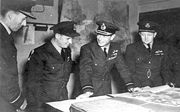
St Vincents Hall
Encyclopedia

Grantham
Grantham is a market town within the South Kesteven district of Lincolnshire, England. It bestrides the East Coast Main Line railway , the historic A1 main north-south road, and the River Witham. Grantham is located approximately south of the city of Lincoln, and approximately east of Nottingham...
industrialist Richard Hornsby
Richard Hornsby
Richard Hornsby was born in Elsham in Lincolnshire on June 4, 1790. He lived with a farming family, the son of William Hornsby and his wife Sarah.-The formation of his company:...
.
Ownership
The Hornsby family sold the property to the Paravicini family who claim descendancy from William the Conqueror before the building was sold to the Air Ministry. The 1920s witnessed many visitors including Tsar Nicholas of Russia's brother fleeing the Bolsheviks.In 1944, the building became headquarters for the USAAF's Ninth Air Force's IX Troop Carrier Command. After the war the house was purchased by the local council and became home to the local planning authority.
During The Second World War
St Vincents Hall is best known for being the HQ of 5 Group Bomber Command between October 1937 and November 1943 and was where Operation ChastiseOperation Chastise
Operation Chastise was an attack on German dams carried out on 16–17 May 1943 by Royal Air Force No. 617 Squadron, subsequently known as the "Dambusters", using a specially developed "bouncing bomb" invented and developed by Barnes Wallis...
of May 1943 - immortalized in the Dambusters film - was planned from. On the night of May 17th 1943 Air Marshall Harris, Barnes Wallis and other RAF high command were in St Vincents Hall when coded radio messages were received confirming that the raid had breached the Mohne and Eder dams. Air Marshall Harris is reputed to have said to Barnes Wallis 'Wallis, I didn't believe a word you said about this damn bomb, but you could sell me a pink elephant now'.
Interior
The House is a Grade II listed building made of Rock Faced limestone with ashlar dressings and steeply pitched Welsh slate roofs, with decorative ridge tiles. Ashlar coped gables with moulded kneelers and finials. North front entrance has central projecting gabled wing, with single storey, lean to, porch to the left. The doorway has a pointed arched moulded ashlar surround, with marble shafts, and hood mould. Above is a moulded ashlar parapet pierced with quatrofoils. To the right a 2-light chamfered window, with tracery, above a single plain sash, in a flat headed chamfered surround, with a pointed inner arch. Above again a 3-light, chamfered mullion window, with a taller central light with cusped heads. At the north-west corner a circular or 'candle wick' tower, of 3 storeys, the lower 2 storeys have 3 single light chamfered lancets, with quatrofoil tracery. The Building stands in 4 acres (16,187.4 m²) of mature grounds with over 40 preserved treesMemorials
The house has two memorials to 5 Group bomber command and 617 squadron. and houses a collection of Bomber Command items.External links
- http://www.raf-lincolnshire.info/grantham/grantham.htm
- http://www.raf.mod.uk/bombercommand/h5gp.html
- http://www.stvincents.info/
- http://www.britishlistedbuildings.co.uk/en-437292-st-vincent-s-house-grantham"
- http://www.infobritain.co.uk/Grantham_Museum.htm
- http://www.telegraph.co.uk/property/propertyadvice/propertymarket/3335271/The-night-of-the-bouncing-bombs.html

